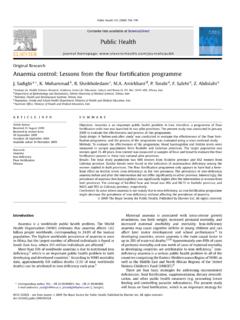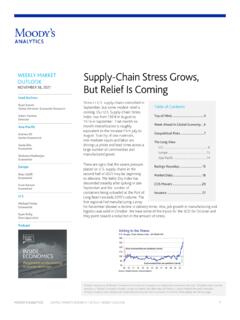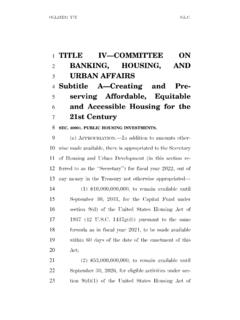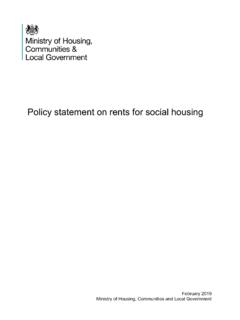Transcription of Setting the Stage for Effective Programs
1 Setting the Stage for Effective Programs Community Assessment Welcome and Introductions Learning Objectives Explain the benefits of conducting a comprehensive community assessment Define the three phases of a community assessment Identify your community assets and needs Determine factors that contribute to community health needs Learning Objectives Locate secondary data for your assessment Identify and select appropriate data collection methods for your community assessment Analyze and prioritize data to inform your program goals and objectives Explore formats for presenting data to community Integrate findings from assessment in grant proposals INTRODUCTION TO COMMUNITY ASSESSMENT Defining community What is Community? A group of people Linked by social ties Sharing common perspectives or interests Who may or may not share a geographic location Community Members Community Members have characteristics in common such as: Common culture or ethnic heritage Where they live Similar age Speak the same language Religion Communities are not homogeneous and seldom speak with one voice Healthy Community A healthy community is a place where people provide leadership in assessing their own resources and needs, where public health and social infrastructure and policies support health, and where essential public health services, including quality health care, are available.
2 -Institute of Medicine, 2003 Healthy Community Clean, safe high quality environment Stable ecosystem Strong, supportive community High degree of public participation Access to a variety of experience and resources Diverse, vital, and innovative city economy Connection to past heritage Appropriate level of access to public health High health status ACTIVITY 1: PLANNING FOR YOUR COMMUNITY NEEDS ASSESSMENT BEGINNING TO DESCRIBE YOUR COMMUNITY What does your community look like? Who is a part of your community? What makes your community and its people special? What is Community Assessment? A process by which community members gain an understanding of the health, concerns, and health care systems of the community by identifying, collecting, analyzing, disseminating information on community assets, strengths, resources, and needs. Program Planning Model Community Assessment Goals and Objectives Program Planning Program Implementation Program Evaluation Dissemination of Results Formative Evaluation Process Evaluation Why do a Community Assessment (CA)?
3 Identify and set priorities based on the need Make decisions about how to improve the community or organization based on needs and available resources Outline goals and objectives of a program Provide standards for an evaluation of a program Why do a Community Assessment (CA)? Identify outside organizations or agencies that may help meet the needs or provide resources To understand the determinants of a health issue Helps to decide how to best address a health issue Provide a systematic basis for which organizational decisions are made Serve as a public relations tool Create an awareness of a community concern or problem Benefits to Conducting CA Strengthening community involvement in decision making Better use of resources Improved communication with the public and other organizations Improving data quality Sustaining health initiatives when resources decline Challenges to Conducting CA Working across professional boundaries- tackling territorial attitudes preventing power or information sharing Lack of shared language between community sectors Lack of commitment from key stakeholders or team members Difficulties in accessing relevant local data Difficulties in accessing the target population Difficulties in
4 Translating findings into Effective action Critical to Understanding Communities Personal opinions, attitudes, risk or behavior assessment Ecological or contextual influences Resources, capacities, or assets available Phase 1 Preassessment Phase 2 Assessment Phase 3 Postassessment Three-Phase Plan for Assessing Needs Utilization Data Gathering Exploration IDENTIFYING ASSETS AND EXPLORING NEEDS Preparing for a community assessment Assets Asset- a capacity that contributes to success Shift of focus from individual and community deficits or needs oriented maps Crime Unemployment Poor housing Assets and capacities that can be tapped or mobilized to address community concern Assets Individual Assets Skills, talents, and experience Individual businesses Home-based enterprises Personal income Gifts of labeled people Organizational Assets Association of businesses Citizens associations Cultural organizations Communication organizations Religious organizations Roles for Individuals in Community Health Talents Leader Connector (gatekeepers) Giver Others Private, Public and Physical Assets Private/Non profits Higher education institutions Hospitals Social services agencies Physical Resources Land, buildings, houses Energy and waste resources Public Institutions and Services Public Schools Government agencies Police/Fire/Safety Libraries Parks Existing Information Resources in Your Community Chamber of Commerce Phone Book Internet Local Newspaper Previous Inventories ( , United Way, Guidestar) Why do we need to assess community assets?
5 Get community involved! Discover resources for health planning Discover community settings and channels for health promotion Find individual or organizational leaders for partnerships Create assets inventory for action planning Individual Asset Inventory Tool Name_____Phone_____Date_____HealthConstr uction & RepairFoodCaring for the ElderlyPaintingCateringCaring for the Mentally IllPlumbingPreparing for Many PeopleCaring for the SickElectricalServing to Many PeopleCaring for Disabled PeopleCarpentryOperating Commercial EquipmentEMT or Emergency First AidBrick and MasonryBakingNursing ExperienceWall PaperingMeat Cutting and PreparationNutritionFurniture RepairsBartendingExerciseLocksmith or Lock RepairsBuilding GaragesTransportationOfficeDry-wall and TapingDriving a CarTyping (WPM_____)CabinetmakingDriving a VanTaking Phone MessagesWelding and SodderingDriving a BusWriting Business LettersConcrete WorkDriving a Tractor-TrailerReceiving Phone OrdersHeating and Cooling SystemsDriving a Commercial TruckOperation SwitchboardFlooring and CarpetingOperating Farm EquipmentBookkeepingRoofingDriving Emergency VehiclesComputer Information EntryOther_____Computer Word ProcessingSupervisionOther_____Maintenan ceWriting ReportsFloor Cleaning/RefinishingFilling Out FormsChild CareCarpet CleaningWorking with a BudgetInfant Care (0-1 yr)Household CleaningRecording of ActivitiesChild Care (1-6 yrs)Lawn Mowing and Yard WorkWriting Proposals or GrantsAdolescent Care (7-13)GardeningPlanning ProjectsTaking Kids on Field TripsTree and Shrubbery CareSupervising ProjectsPre-school CareOther_____Source: Vitalizing Communities, Community Guide, 1999, J.
6 Allen, S. Cordes, and J. Hart, p. 28 Individual Skills/Assets InventoryInventory Tool 1 AAssociation Asset Inventory Tool Community_____Date_____Page ____ of ____ Name of AssociationContact Person/InfoMissonAudience/PopulationProg ram/Services OfferedExamples: Business Association: Chamber of Commerce, neighborhood business associations, trade groups,.. Charitable Groups/Drives: Red Cross, Cancer Society, United Way, Diabetes Association,.. Youth Groups: 4-H Clubs, Future Farmers, Girl Scouts, Boy Scouts, YMCA, YWCA,.. Civic Events: art fair, health fair, 4th of July, town festival,..Source: Adaptation of: Vitaling Communities, Community Guide, 1999. J. Allen, S. Cordes, and J. Hart, Assets InventoryInventory Tool 2 ACTIVITY 2: COMMUNITY ASSET INVENTORY What are your community s individual assets? What are your community s association assets? What is a Needs Assessment (NA)? A systematic set of procedures undertaken for the purpose of Setting priorities and making decisions about program or organizational improvement and allocation of resources.
7 The priorities are based on identified needs. Community Needs Need: a discrepancy or gap between what is and what is desired or should be Types of Needs Normative: need relative to some standard ( , Healthy People 2010 objectives) Perceived: felt needs of people Expressed: needs based on behavior ( , seeking of that need; met or unmet demand) Relative: needs relative to other communities/geography ( , county, state) Levels of Needs Primary stakeholders (Level 1): service receivers-clients, patients, consumers Secondary (Level 2): service providers and policy makers-health care professionals, administrators Tertiary (Level 3): resources or solutions: buildings, facilities, supplies, technology Other Considerations Community needs assessment exist with external forces: Funding sources Physical environment Political factors Organizational mandates Factors that Influence Need To understand a community, you must understand the factors that cause health disparities and health problems.
8 There are health models that guide the process of diagnosing a community s health and identifying needs. PRECEDE Model for Community Assessment Planning is based on multiple disciplines: epidemiology; the social, behavioral, and educational sciences; and health administration Two fundamental propositions: (1) health and health risks are caused by multiple factors (determinants) (2) because health and health risks are determined by multiple factors, efforts to effect behavioral, environmental, and social change must be multidimensional or multisectoral, and participatory. PRECEDE Assessment Steps Step 1: Social diagnosis Step 2: Epidemiological diagnosis Step 3: Behavioral and environmental diagnosis Step 4: Educational and Organizational Diagnosis Step 5: Administrative and Policy Diagnosis Absenteeism Achievement Aesthetics Alienation Comfort Quality of life Subjectively defined problems and priorities of individuals or communities Crime Crowding Discrimination Happiness Hostility Illegitimacy Performance Riots Self-esteem Unemployment Votes Welfare Step 1: Social Diagnosis Example of Step 1: Social Diagnosis Childhood obesity is rising in your community Disability Discomfort Fertility Fitness Health Identify specific health goals or problems that may contribute to social goals from Phase 1 Morbidity Mortality Physiological Risk Factors Step 2: Epidemiological Diagnosis Example of Step 2: Epidemiological Diagnosis How do you know it is a problem?
9 Number of children identified as overweight Number of children identified as obese Number of other chronic conditions (diabetes, heart disease) Compliance Consumption patterns Coping Behavior Identify specific health-related behavioral and environmental factors Preventive actions Self-care Healthcare Utilization Environment Step 3: Behavioral and Environmental Diagnosis Access affordability Equity Example of Step 3: Behavioral and Environmental Diagnosis Behavioral conditions related to obesity Eating habits Physical activity Environmental conditions related to obesity Availability of healthy eating in neighborhood Convenience of fast foods Places to participate in physical activity Safety of outdoor areas Predisposing factors Predisposing factors: Reinforcing factors Enabling factors Knowledge Attitudes Beliefs Values Step 4: Educational and Organizational Diagnosis Examines conditions linked to health status to determine what causes them Reinforcing factors: Attitudes of health personnel, peers, family members Enabling factors: Availability of resources Accessibility Referrals Rules/Laws Example of Step 4: Educational and Organizational Diagnosis Predisposing Factors: conditions that provide the rationale or motivation for a behavior taste of fatty, high sugar, high calorie foods; wanting to be health and look attractive Reinforcing Factors: factors subsequent to a behavior that provide a reward or incentive toys in fast food kids meals; colleague support of healthy eating habits Enabling Factors: antecedents to behavior that facilitate a motivation to be realized Convenience of a drive through.
10 Menu labeling Health Education Reviewing identified barriers and initiating organizational, regulatory and policy changes to overcome those barriers Assessment of: Policy regulation organization Resources needed Available resources Barriers to implementation Step 5: Administrative and Policy Diagnosis Assessment of: Policies and regulations Political forces Example of Step 5: Administrative and Policy Diagnosis Health Education: a coordinated school health approach for children that increases physical activity, decreases fat and caloric intake, and increases fruit and vegetable consumption Policy regulation/organization: Healthy school lunch Programs and implementation of nutritional standards and regulations Questions? What are some examples of these steps for your topics? Phase 1: Preassesment Exploring and Organizing for Action Phase 1: Preassessment Set up CA committee Investigate what is already known about the needs of the target group Determine the focus and scope of the assessment Determine specific data to collect and how data will be used Exploration Stakeholders and Target Population Stakeholders key contact and other key informants in the community, public health organizations and other related services, target population Key agencies, participants, health professionals Partners Coalition members, advisory board members Target Population people directly affected by the needs assessment process (often termed priority population) Questions?



